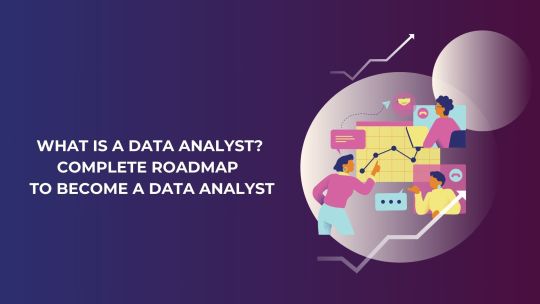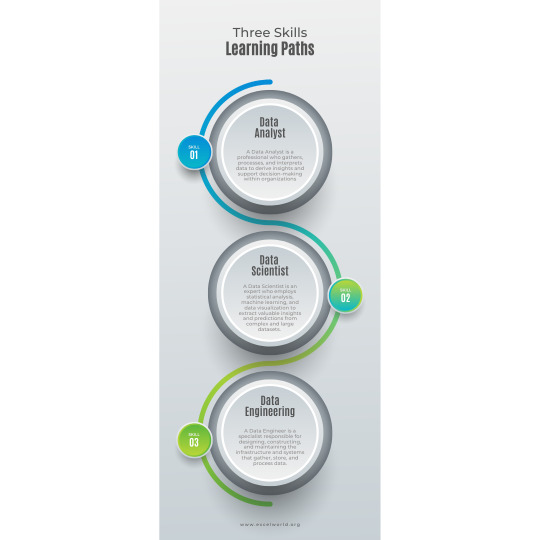#dataanalysts
Explore tagged Tumblr posts
Text
What is a Data Analyst? | Complete Roadmap to Become a Data Analyst

In today’s data-driven world, businesses rely on data analysts to convert raw data into actionable insights. Data analysts play a crucial role in enabling organizations to make informed decisions, optimize operations, and identify new opportunities. If you aspire to become a data analyst, understanding the responsibilities, required skills, and career path is essential. This article provides a detailed roadmap to guide your journey toward a successful career as a data analyst.
Who is a Data Analyst?
A data analyst is a professional who collects, processes, and interprets data to help organizations make data-driven decisions. Their work involves identifying patterns, trends, and relationships in datasets and presenting findings through visualizations and reports. Data analysts serve as the bridge between raw data and strategic decision-making, impacting various sectors such as healthcare, finance, retail, and technology.
Key Responsibilities of a Data Analyst
Data analysts perform a variety of tasks, including:
1. Data Collection: Gathering relevant data from multiple sources, such as databases, APIs, and spreadsheets.
2. Data Cleaning: Removing inconsistencies, duplicates, and errors to ensure data quality.
3. Data Analysis: Using statistical techniques to identify patterns and trends.
4. Data Visualization: Presenting data insights using charts, graphs, and dashboards.
5. Reporting: Preparing detailed reports to communicate findings to stakeholders.
6. Collaborating with Teams: Working closely with decision-makers to understand business needs and provide actionable recommendations.
Skills Required to Become a Data Analyst
1. Technical Skills
· Excel: Proficiency in Excel is essential for basic data manipulation and analysis.
· SQL: Knowledge of SQL helps you extract and manage data from relational databases.
· Programming: Skills in Python or R are crucial for advanced data analysis and visualization.
· Data Visualization Tools: Familiarity with tools like Tableau, Power BI, and Matplotlib enhances your ability to present insights effectively.
· Statistics and Mathematics: A strong foundation in statistical concepts is necessary for analyzing and interpreting data.
2. Soft Skills
· Critical Thinking: The ability to approach problems logically and think analytically.
· Communication: Skills to convey complex findings in a simple, understandable manner.
· Attention to Detail: Ensuring data accuracy and quality.
· Problem-Solving: Using data to address business challenges and propose solutions.
Roadmap to Becoming a Data Analyst
Here’s a step-by-step guide to help you achieve your goal of becoming a data analyst:
1. Understand the Role
Research the responsibilities, required skills, and career opportunities in data analytics. Read job descriptions and connect with industry professionals to gain a deeper understanding of the field.
2. Learn the Basics
· Start with learning Microsoft Excel for data manipulation.
· Gain proficiency in SQL to query and manage databases.
· Explore Python or R for statistical analysis and scripting.
3. Build a Strong Foundation in Statistics
Understand statistical concepts like mean, median, variance, standard deviation, and probability distributions. These are essential for interpreting and analyzing data.
4. Develop Visualization Skills
Learn how to create impactful visualizations using tools like Tableau, Power BI, or programming libraries like Matplotlib and Seaborn.
5. Work on Real-World Projects
Gain practical experience by working on projects such as:
· Analyzing sales data to identify trends.
· Creating dashboards to monitor KPIs.
· Performing customer segmentation based on purchase behavior.
6. Obtain Certifications
Certifications can validate your skills and boost your employability. Consider certifications like:
· Google Data Analytics Professional Certificate
· Microsoft Certified: Data Analyst Associate
· Certification programs offered by 360DigiTMG
7. Build a Portfolio
Showcase your skills through a portfolio that includes:
· Completed projects with detailed documentation.
· Visualizations and dashboards you’ve created.
· Contributions to open-source projects or Kaggle competitions.
8. Network and Apply for Jobs
· Join professional platforms like LinkedIn to connect with data analysts and recruiters.
· Attend webinars, workshops, and meetups to stay updated on industry trends.
· Apply for internships or entry-level positions to gain hands-on experience.
The Future of Data Analytics
The field of data analytics is rapidly evolving, with advancements in technology and the growing importance of data in decision-making across industries. Emerging trends and tools are shaping the future of the profession, making it an exciting time to enter the field. As a data analyst, staying updated with these trends can ensure long-term career success and growth.
youtube
1. Integration of AI and Machine Learning
Data analysts are increasingly using AI and machine learning tools to automate data preparation, identify complex patterns, and generate predictive insights. Familiarizing yourself with these technologies can give you a competitive edge.
2. Big Data Analytics
With the explosion of data generated every day, analysts are expected to work with massive datasets. Learning big data technologies like Apache Hadoop and Spark can be advantageous.
3. Data Storytelling
The ability to communicate insights effectively through compelling stories is gaining prominence. Developing skills in data storytelling and mastering tools like PowerPoint and Canva for presentations will be crucial.
4. Cloud-Based Analytics
Cloud platforms like AWS, Google Cloud, and Azure are becoming popular for data storage and analysis. Understanding how to use these platforms will enhance your job prospects.
5. Specialized Roles
As the field matures, specialized roles such as marketing analyst, healthcare analyst, and risk analyst are becoming common. Building domain expertise in a specific industry can open new opportunities.
Benefits of Becoming a Data Analyst
Pursuing a career in data analytics offers several advantages:
1. High Demand: With businesses across industries relying on data, the demand for skilled data analysts continues to grow.
2. Attractive Salaries: Data analysts often earn competitive salaries, with opportunities for bonuses and incentives.
3. Diverse Opportunities: Data analysts can work in various industries, providing flexibility and a chance to explore different fields.
4. Career Growth: With experience, you can transition to higher roles, such as data scientist, analytics manager, or consultant.
5. Intellectual Satisfaction: The role involves solving challenging problems and contributing to impactful decisions, making it fulfilling for those who enjoy analytical thinking.
Why Choose 360DigiTMG for Your Data Analyst Journey?
360DigiTMG is a leading training provider that equips aspiring data analysts with the skills and knowledge needed to excel in the field. Here’s how 360DigiTMG can support your journey:
· Comprehensive Curriculum: Learn essential tools and techniques, including Excel, SQL, Python, and Tableau.
· Hands-On Projects: Gain practical experience by working on real-world datasets and projects.
· Global Certifications: Earn certifications that are recognized by top employers worldwide.
· Experienced Faculty: Learn from industry experts with years of practical experience in data analytics.
· Placement Assistance: Benefit from resume-building workshops, mock interviews, and job placement support.
· Flexible Learning Options: Choose from online, offline, and hybrid learning modes to suit your schedule.
By enrolling in 360DigiTMG’s data analyst programs, you not only gain technical expertise but also the confidence to thrive in a competitive job market.
Conclusion
Becoming a data analyst is a rewarding journey that requires a mix of technical skills, problem-solving abilities, and industry knowledge. With a clear roadmap and the right guidance, you can build a successful career in this dynamic field. Whether you are just starting or looking to upskill, 360DigiTMG offers the resources and expertise to help you achieve your career goals. Take the first step today and unlock your potential as a data analyst!
1 note
·
View note
Text
Data Analysts: The Key to Empowering Smart Decision-Making
Data analysts play an important role in helping organizations make informed decisions. In a world where data is essential for business success, their skills in understanding complex data, finding patterns, and revealing useful insights are invaluable. By turning raw data into clear and meaningful information, analysts give leaders a strong base for making decisions based on facts rather than just guessing.
These professionals connect complicated data with practical insights, allowing teams in areas like marketing, finance, and operations to make choices that support overall business goals. For example, a marketing team might use insights from data analysts to improve their campaigns by targeting specific customer groups more effectively, while finance teams may look at budgeting trends to allocate resources better.
Data analysts also use various tools and methods, such as data visualization and statistical analysis, to present their findings in an easy-to-understand way. This approach not only helps people grasp the information quickly but also encourages teamwork, as everyone can engage with the data and see what it means.
In the end, by providing organizations with clear and useful information, data analysts play a key role in a company’s success. Their ability to turn data into actionable strategies helps businesses face challenges and take advantage of opportunities confidently. Ultimately, data analysts are vital in bridging the gap between raw data and informed decision-making, empowering organizations to make smart choices in today’s data-driven world.
#DataAnalysts#DataDrivenDecisions#BusinessIntelligence#DataInsights#DataVisualization#DataAnalysis#InformedDecisions#DataForBusiness#AnalyticsTools#BusinessGrowth#StrategicPlanning#DataSuccess#MarketingAnalytics#FinancialInsights#TeamworkInBusiness#DataScience#DecisionMaking#DataEmpowerment#StatisticalAnalysis#ActionableInsights#DataStrategy#BusinessOpportunities#SmartDecisions#DataDrivenSuccess
1 note
·
View note
Text
How Can I Become a Data Analyst in Pune? A Complete Guide

Introduction In today’s data-driven world, data analysts are essential for helping organizations make informed decisions. Pune, a growing tech hub in India, is home to numerous opportunities for aspiring data analysts. If you’re wondering how to become a data analyst in Pune, this guide will provide you with step-by-step insights to get you started on your journey. Whether you’re new to the field or looking to advance your career, we’ll cover the essential skills, qualifications, and training programs required to kickstart your career. Plus, we’ll introduce you to the advanced training programs offered at Ethans Tech in collaboration with E&ICT, IIT-Guwahati, to set you apart from the competition.
Step 1: Understand the Role of a Data Analyst
Before you start your journey to becoming a data analyst, it’s important to understand what the role entails. Data analysts are responsible for gathering, cleaning, and interpreting data to help organizations make strategic decisions. They use various tools and technologies to visualize data and present it to stakeholders.
Key Responsibilities of a Data Analyst:
Collecting and organizing data from various sources.
Performing statistical analysis and identifying trends.
Visualizing data through tools like Tableau, Power BI, and Excel.
Collaborating with teams to provide actionable insights.
Step 2: Develop the Essential Skills to Become a Data Analyst
To succeed as a data analyst, you need to master a set of technical and soft skills. These include:
Technical Skills:
Data Manipulation & Analysis: Excel, SQL, and Python for analyzing data sets.
Programming: Python and R for statistical analysis and automation.
Data Visualization: Tableau, Power BI, and Matplotlib to present data clearly.
Database Management: SQL and other database systems to query and manage data.
Machine Learning Basics: Understanding how predictive modeling works can be a bonus.
Soft Skills:
Analytical Thinking: The ability to interpret data and spot patterns.
Communication Skills: Presenting complex data in an easy-to-understand manner.
Problem-Solving: Approaching challenges with a solutions-focused mindset.
Step 3: Get Certified with a Reputable Data Analyst Course
While self-learning is an option, enrolling in a structured course helps you gain comprehensive knowledge and hands-on experience. Ethans Tech offers a Data Science & AI Certification in collaboration with E&ICT, IIT-Guwahati, one of the most prestigious institutions in India. This advanced program is designed to equip you with the skills needed to thrive in data analytics, giving you an edge in Pune’s competitive job market.
Why Choose Ethans Tech?
Industry-Relevant Curriculum: Learn data analytics, Python, SQL, machine learning, and more.
Expert Trainers: Get taught by industry veterans with real-world experience.
Hands-On Projects: Gain practical experience through live projects and case studies.
Certification from E&ICT, IIT-Guwahati: Elevate your resume with a certification from a top-tier institute.
Placement Assistance: Ethans Tech has a dedicated placement team that helps you secure jobs with top companies in Pune and beyond.
Step 4: Gain Practical Experience Through Projects
Practical experience is key to becoming a successful data analyst. Make sure to engage in live projects and internships to apply what you’ve learned. The certification program at Ethans Tech includes multiple real-world projects, which give you the opportunity to work with data, clean it, analyze trends, and present solutions to problems. This practical knowledge is invaluable when applying for jobs.
Step 5: Build Your Portfolio
As you gain more experience, start building a portfolio showcasing your skills. Include projects that demonstrate your ability to work with data, use tools like Tableau and SQL, and provide actionable insights. A strong portfolio will make you stand out to potential employers in Pune’s data analytics job market.
Step 6: Apply for Jobs in Pune’s Thriving Data Analytics Market
Once you have completed your training and built a solid portfolio, it’s time to start applying for jobs. Pune has a growing demand for data analysts in industries like IT, finance, healthcare, and e-commerce. With the help of Ethans Tech’s placement assistance, you’ll have access to a network of employers looking for skilled data analysts.
FAQs About Becoming a Data Analyst in Pune
1. What qualifications do I need to become a data analyst in Pune? To become a data analyst, you’ll need a combination of a bachelor’s degree (preferably in fields like mathematics, statistics, computer science, or engineering) and technical skills like proficiency in Excel, SQL, Python, and data visualization tools.
2. How long does it take to become a data analyst? If you’re starting from scratch, it could take anywhere from 6 months to a year to develop the necessary skills, especially if you enroll in a structured course like the one offered by Ethans Tech. The duration depends on your learning pace and the complexity of the tools you need to master.
3. What is the average salary for a data analyst in Pune? The average salary for a data analyst in Pune ranges from ₹4 to ₹6 lakhs per annum for freshers. With experience, this can rise significantly, especially in high-demand industries.
4. Can I become a data analyst without a degree? While a degree can give you an edge, it’s not mandatory. With the right certification program like the E&ICT, IIT-Guwahati certification offered by Ethans Tech, and strong technical skills, you can secure a job as a data analyst without a formal degree in the field.
5. Is Pune a good city to start a career in data analytics? Absolutely! Pune is emerging as a major tech hub in India, and companies across industries are seeking skilled data analysts to make data-driven decisions. The city offers numerous opportunities, competitive salaries, and a supportive professional environment.
Kickstart Your Data Analyst Career in Pune with Ethans Tech
Becoming a data analyst in Pune is a lucrative career choice, with ample opportunities across various industries. By enrolling in a Data Science & AI course at Ethans Tech — certified by E&ICT, IIT-Guwahati — you’ll gain the skills, knowledge, and certification needed to excel. From practical experience through hands-on projects to placement assistance, Ethans Tech is your partner in building a successful career in data analytics.
Don’t wait — enroll today and start your journey toward becoming a top-tier data analyst in Pune!
#datascience#machinelearning#python#datascientist#dataanalytics#datasciencejobs#artificialintelligence#career#r#ai#deeplearning#datasciencetraining#pythonprogramming#ml#interviewquestions#dataanalysts#corporatetraining#onlinelearning#dataanalyst#data#coding#programming#datasciencelearning#tableau
0 notes
Text
Infographics for Data Presentation
In the era of big data, effectively presenting information is crucial. Infographics, combining visuals with data, have become indispensable tools for translating complex data into understandable and engaging formats. This article explores the significance of infographics in data presentation and how they enhance data comprehension, while integrating insights about various data analytics training options.
The Power of Infographics
Infographics harness the power of visual storytelling. They use a blend of graphics, charts, and text to convey information at a glance. The human brain processes images 60,000 times faster than text, making infographics a potent tool for quick comprehension. By representing data visually, infographics break down intricate details into more digestible chunks, which can be especially useful in fields such as business intelligence, marketing, and education.
An effective infographic does more than just display data; it tells a story. The strategic use of design elements, such as color, typography, and layout, guides the viewer's focus and highlights key insights. This visual approach not only makes data more accessible but also more engaging, increasing the likelihood that the information will be remembered and acted upon.
Choosing the Right Infographic for Your Data
Selecting the appropriate type of infographic is essential for effective data presentation. Common types include:
Statistical Infographics: Best for presenting quantitative data through charts and graphs.
Informational Infographics: Useful for explaining concepts or processes through a combination of text and visuals.
Timeline Infographics: Ideal for illustrating historical data or project timelines.
Comparison Infographics: Effective for contrasting two or more data sets.
Each type serves a different purpose and should be chosen based on the nature of the data and the intended audience. For those seeking to develop their skills in data presentation, engaging in a data analytics online course can provide a solid foundation. These courses often cover various techniques for visualizing data and the principles behind effective infographic design.
Integrating Infographics with Data Analytics Training
Incorporating infographics into your data analytics practice requires understanding both design principles and data analysis techniques. Many data analyst online training with internship programs include modules on data visualization, offering hands-on experience in creating impactful infographics. These programs teach you how to interpret data, select the right visual elements, and design infographics that communicate insights clearly and effectively.
For those interested in a more structured learning environment, an offline data analytics certification course might be suitable. These courses provide in-depth knowledge of data analysis and visualization, helping students grasp the nuances of infographic design while applying data analysis skills.
The Role of Infographics in Job Placement
Infographics are not only useful for presenting data but also for showcasing your skills. In a competitive job market, a well-designed infographic resume can make a significant impact. Many data analytics certification programs emphasize the importance of personal branding and often include modules on creating professional infographics to enhance your job applications.
Moreover, a data analytics course with job placement assistance can help you leverage infographics in your job search. These programs often provide training on how to effectively use visual tools to demonstrate your analytical skills and achievements, making your profile stand out to potential employers.
Certified Data Analyst Course
youtube
Advanced Techniques in Infographic Design
To create compelling infographics, it’s essential to master advanced design techniques. This includes understanding color theory, typography, and the principles of visual hierarchy. Advanced infographics might incorporate interactive elements or animations, which can further engage viewers and provide a more immersive experience.
Incorporating these techniques into your data presentation can be part of advanced data analyst training. Whether you choose an offline data analytics certification course or data analyst offline training, these programs can provide a comprehensive education in both data analysis and advanced infographic design.
Evaluating the Effectiveness of Infographics
The effectiveness of an infographic can be measured by its ability to convey the intended message clearly and engage the audience. Metrics such as viewer engagement, comprehension rates, and feedback can help assess how well an infographic performs.
Incorporating analytics into your infographic strategy can be part of a data analyst certification course, where you learn to use data to evaluate and improve your visual presentations. Understanding how to measure and analyze the impact of your infographics ensures that they meet their intended goals and provide value to the audience.
Infographics are a powerful tool for data presentation, transforming complex information into visually appealing and easily digestible formats. By leveraging effective infographic design and data analysis skills, you can enhance communication, engage your audience, and make data-driven decisions more accessible.
For those looking to advance their skills, exploring the best data analytics courses can provide valuable insights into both data visualization and analysis. Whether through data analytics online training with internship or offline data analyst training, these programs can equip you with the skills needed to create impactful infographics and advance your career in data analytics.
Data Scientist vs Data Engineer vs ML Engineer vs MLOps Engineer
youtube
#dataanalysis#data analyst training#dataanalyticstraining#dataanalyticscourse#dataanalysttraining#dataanalysts#dataanalytics#Youtube
0 notes
Text
Distinguishing Between Data Analyst and Data Scientist Roles
In the world of data-driven decision-making, two roles stand out prominently: Data Analysts and Data Scientists. While they may sound similar, these roles have distinct responsibilities, skill sets, and career paths. Understanding the differences between them is crucial for individuals looking to enter the field of data analytics. If you're considering a career in this dynamic field, you might be wondering: What sets a Data Analyst apart from a Data Scientist? Let's delve into the details.
Introduction: Navigating the Data Landscape
In today's digitally connected world, data has become a cornerstone of businesses across industries. From retail to healthcare, from finance to manufacturing, organizations rely on data to drive strategic decisions, optimize processes, and gain competitive advantages. As the volume and complexity of data continue to grow, so does the demand for skilled professionals who can interpret, analyze, and derive insights from it.
This brings us to the roles of Data Analysts and Data Scientists. While both roles involve working with data, they serve different purposes within an organization's data ecosystem. Let's explore each role in detail, starting with Data Analysts.
Data Analyst: Building Foundations
Data analysts play a crucial role in gathering, processing, and interpreting data to support organizational decision-making. They primarily handle structured data stored in databases or spreadsheets, employing tools such as SQL, Excel, and Tableau to derive meaningful insights. Data Analytics Training programs typically concentrate on honing skills in these tools and imparting essential data analysis methodologies.
Understanding the Role of a Data Analyst
Data Analysts play a vital role in transforming raw data into actionable insights. They are skilled in identifying trends, patterns, and correlations within datasets. By analyzing historical data and generating reports, Data Analyst course assist stakeholders in understanding past performance and making data-driven decisions. Additionally, they may be involved in data visualization tasks, creating charts, graphs, and dashboards to communicate findings effectively.
Skills Required for Data Analysts
To excel as a Data Analyst, individuals need a combination of technical and analytical skills. Proficiency in programming languages like SQL, Python, or R is essential for data manipulation and analysis. Strong critical thinking and problem-solving abilities enable Data Analysts to interpret data accurately and draw meaningful conclusions. Effective communication skills are also crucial for conveying insights to non-technical stakeholders in an understandable manner.
Data Scientist: Going Beyond Analysis
Data Scientist Training programs go a step further, equipping individuals with advanced skills in statistics, machine learning, and predictive modeling. Data Scientists work with both structured and unstructured data, leveraging techniques like regression analysis, clustering, and natural language processing to extract insights and build predictive models.
Exploring the Role of a Data Scientist
Data Scientists are tasked with solving complex problems using data-driven approaches. They delve deep into data sets, uncovering hidden patterns and relationships that can inform strategic decision-making. Unlike Data Analysts, who focus primarily on descriptive analytics, Data Scientists engage in predictive and prescriptive analytics, forecasting future trends and recommending actions based on insights derived from data.
Skills Required for Data Scientists
Achieving proficiency as a Data Scientist demands a varied skill set, which includes expertise in statistics, machine learning, and programming. Mastery of programming languages like Python or R is crucial for tasks ranging from data manipulation to model construction and analysis. Moreover, Data Scientists must possess a robust comprehension of statistical principles and methodologies to validate models and accurately interpret findings. Furthermore, possessing strong problem-solving skills and fostering creativity are indispensable for addressing intricate data-related issues.
Data Analyst: Bridging the Gap
Data Analysts and Data Scientists have clearly defined roles, but there is frequent crossover between them. Often, professionals begin their careers as Data Analysts and later transition into Data Scientist positions as they accumulate experience and skills. Data Analyst Course Training programs offer a strong basis in fundamental data analysis principles, preparing individuals for further advancement in the field of data science.
Summary
In summary, Data Analysts and Data Scientists play integral roles in the data-driven decision-making process. While Data Analysts focus on descriptive analytics, extracting insights from structured data to support operational decisions, Data Scientists delve deeper into data sets, employing advanced techniques to uncover patterns, make predictions, and drive strategic initiatives. Whether you're drawn to the analytical rigor of data analysis or the predictive power of data science, there are abundant opportunities for individuals with the right skills and training. By understanding the differences between these roles and investing in relevant data analyst offline training, you can chart a rewarding career path in the dynamic field of data analytics.
0 notes
Text

Hyderabad’s Hiring Hub: Post Vacancy and Find The Perfect Employee💼 👇
Are you wondering why the goals of the recruitment are important? Unemployment is at a lower level in India.
Organizations are severely competing to find the best candidates to fill their vacancies. Moreover, the hiring teams are under huge pressure to increase the bar. It implies checking and improving the different aspects of the recruitment trip. That’s where recruitment goals approach.
Go for the Post Job 👈 Free in Hyderabad support available for the interested users:
𝐕𝐢𝐬𝐢𝐭: https://www.placementindia.com/blog/hyderabads-hiring-hub.htm
#hyderabadhiringhub#postvacancy#jobpostinhyderabad#itprofessional#jobpost#mechanicalengineer#opportunitiesforengineeringjobs#engineeringjobs#dataanalysts#softwareengineer#graphicdesigner#managerialpost#postjobfreeinhyderabad#postjobfree#placementsolutions#recruitcandidate
0 notes
Text

#DataAnalysts#DataAnalysis#DataInsights#DecisionMaking#DataProcessing#DataVisualization#ExcelAnalysis#SQLQueries#PythonAnalysis#RProgramming#DataTools#StatisticalAnalysis#DataVisualizationTools#ETLTools#DataCleaning#MachineLearning#TechnicalSkills#BusinessStrategies#DataManagement#microsoftedu
1 note
·
View note
Text
instagram
ou can become a data analyst ⤵️📈📊💯 Here’s what you need to do: - believe in yourself - learn Excel -learn SQL - learn Tableau - build Portfolio - update Linkedin - optimize Resume - Use Network -apply for jobs That’s the way. . . .
#data#dataanalyst#dataanalytics#analyst#analytics#workfromhome#codinglife#tech#teknoloji#programming#datascience#programmer#python#machinelearning#artificialintelligence#deeplearning#code#ai#Instagram
5 notes
·
View notes
Text
The SQL Server Configuration Manager is a centralized utility that simplifies network configuration, client protocols, and administration of SQL service. Let's Explore Deeply:
https://madesimplemssql.com/sql-server-configuration-manager/
Please follow us on FB: https://www.facebook.com/profile.php?id=100091338502392
OR
Join our Group: https://www.facebook.com/groups/652527240081844
3 notes
·
View notes
Text
7 Best Data Analyst Courses That You Shouldn't Miss!
Hello learners,
We, at CourseCorrect have selected the best courses for becoming a Data Analyst.
Have a look at them in our latest blog here
#datascience#data analytics#dataanalyst#data analyst training#dataanalystcourseinbangalore#dataanalystcourse
3 notes
·
View notes
Text
What Drives Data Analyst Salaries? An In-Depth Analysis
Educational Background: Higher degrees (master's or Ph.D.) often lead to better salaries than a bachelor’s.
Experience Level: More years of experience typically result in higher compensation.
Industry: Analysts in finance, healthcare, and technology generally earn more than those in retail or education.
Location: Salaries vary by geographic area, with major cities typically offering higher pay.
Skills and Specializations: Proficiency in data visualization tools (like Tableau or Power BI), programming languages (Python, R), and machine learning boosts earning potential.
Certifications: Relevant certifications, including PMP certification and other project management certifications, can enhance salaries.
Company Size: Larger firms often provide better salaries and benefits.
Market Demand: Increased demand for data analysts typically drives up salaries.
In conclusion, several key factors influence data analyst salaries, including educational background, experience level, industry, geographic location, skills and specializations, certifications, company size, and market demand. By understanding these elements, aspiring data analysts can strategically focus on enhancing their qualifications and expertise to improve their earning potential.
#DataAnalyst#Salaries#CareerDevelopment#DataScience#Certifications#DataVisualization#Education#JobMarket#DataSkills#CareerGrowth
2 notes
·
View notes
Text
𝐃𝐞𝐦𝐲𝐬𝐭𝐢𝐟𝐲𝐢𝐧𝐠 𝐀𝐩𝐩𝐫𝐞𝐧𝐭𝐢𝐜𝐞𝐬𝐡𝐢𝐩𝐬: 𝐔𝐧𝐯𝐞𝐢𝐥𝐢𝐧𝐠 𝐭𝐡𝐞 𝐁𝐞𝐧𝐞𝐟𝐢𝐭𝐬 𝐨𝐟 𝐀𝐩𝐩𝐫𝐞𝐧𝐭𝐢𝐜𝐞𝐬𝐡𝐢𝐩𝐬





#NAW2024#businessadministration#DataAnalyst#Apprenticeships#DataTech#assistantaccountant#BlazeATrail#apprenticeshipprogram#SkillsForTheFuture#ApprenticeshipWorks#NationalApprenticeshipWeek#careeropportunities#apprenticeweek2024#earnwhileyoulearn#PowerYourLife#PowerYourCareer#teenage#degree#careeradvice#FutureCareer#Labour#HousingManagement#propertymanagement#ProfessionalGrowth#professionalaccountant
2 notes
·
View notes
Text
Bayesian Statistics: A Comprehensive Overview
Bayesian statistics is an approach to data analysis that emphasizes flexibility and adaptability, making it particularly useful for real-world applications where uncertainty and new information are constantly in play. Unlike classical statistics, which tends to rely heavily on fixed assumptions, Bayesian methods allow us to continuously update our understanding as new data becomes available. This makes it a natural fit for modern data analytics, which often deals with evolving datasets and dynamic environments.
For those looking to build a strong foundation in data analytics, enrolling in a data analytics online course can be a great step towards understanding Bayesian principles. These courses often cover a wide range of techniques, including Bayesian methods, which are crucial for addressing the complexities found in real-world data.
The Bayesian Approach: A New Way to Think About Data
In the traditional or "frequentist" approach to statistics, probabilities are thought of as long-term frequencies of events occurring. In contrast, Bayesian statistics takes a more flexible approach, where probability represents a degree of belief or certainty. As new data comes in, Bayesian methods allow for this probability to be updated, helping analysts refine their models and predictions.
This iterative process is key to why Bayesian statistics is so valuable in modern analytics. With data coming from many different sources and in real-time, it’s essential to be able to adjust predictions and models as new information becomes available. Many offline data analytics certification courses now include modules that focus on Bayesian methods, recognizing their importance in today's data-driven world.
For instance, if an analyst is working on a project to forecast demand for a product, initial beliefs about demand can be based on historical sales data. However, as new data such as customer preferences or market trends emerge, these beliefs can be updated using Bayesian techniques, allowing for more accurate and timely forecasts. This ability to integrate new information seamlessly is one of the reasons why Bayesian statistics has gained such prominence in the field.
Prior Knowledge and the Role of Data
One of the most distinctive features of Bayesian statistics is its ability to incorporate prior knowledge. In many real-world scenarios, we don’t start from zero. There’s often prior information—whether from expert judgment, past studies, or historical data—that can guide analysis. Bayesian methods allow analysts to incorporate this prior knowledge into their models, improving their ability to make informed decisions.
For those pursuing a data analyst certification course, mastering Bayesian approaches to prior knowledge can be a powerful skill. This approach ensures that any previous understanding of a problem isn't discarded but is rather used in conjunction with new data to enhance the final results. Bayesian statistics, in this way, becomes an indispensable tool for analysts tasked with decision-making under uncertainty.
Furthermore, Bayesian statistics doesn't just work in theoretical spaces; its applications span industries from healthcare to finance, where updating beliefs as new data is collected can save time, money, and even lives. Whether you're undergoing data analyst offline training or online sessions, learning how Bayesian principles apply to your specific industry can make you a more agile and effective analyst.
Applications in Real-World Data Analytics
Bayesian statistics shines in situations where data is scarce, uncertain, or constantly changing. It’s particularly well-suited to modern data analytics problems like predictive modeling, A/B testing, and decision-making under uncertainty. As companies collect more and more data, the need to process and interpret it efficiently becomes paramount. Bayesian methods provide a robust framework for updating models as new data is gathered, making it easier for analysts to generate actionable insights.
Many data analytics online training with internship programs introduce students to Bayesian methods early on, as they help in building models that reflect real-world uncertainty. For example, in marketing, Bayesian techniques can help optimize advertising strategies by continually updating the effectiveness of different campaigns based on incoming data.
Moreover, Bayesian approaches are often integrated into machine learning algorithms, another core component of modern analytics. This is one of the reasons why the best data analytics courses include a thorough examination of Bayesian statistics, allowing learners to understand the intersection between statistical theory and cutting-edge technology.
Data Scientist vs Data Engineer vs ML Engineer vs MLOps Engineer
youtube
The Future of Bayesian Statistics in Data Analytics
As the data analytics field continues to evolve, Bayesian statistics will likely play an increasingly important role. The ability to refine models, update predictions, and make decisions in uncertain environments is essential in a world where data is constantly changing. The growing complexity of data requires advanced analytical techniques, and Bayesian statistics is well-suited to meet these challenges.
Enrolling in a data analytics certification or a specialized course that covers Bayesian methods can provide a competitive edge in the job market. Employers are increasingly looking for candidates who can navigate complex datasets and make informed decisions. Understanding Bayesian techniques equips data professionals with the tools they need to succeed in this fast-paced environment.
For students who are looking for a more practical learning experience, choosing a data analytics course with job placement can provide the opportunity to apply Bayesian methods in real-world scenarios. These placements help solidify theoretical knowledge through hands-on projects, bridging the gap between learning and application.
Bayesian statistics represents a comprehensive and adaptable framework for interpreting data in modern analytics. Its flexibility in incorporating prior knowledge and updating predictions as new data comes in makes it ideal for tackling the challenges faced by today’s data analysts. Whether through a top data analytics institute or other learning platforms, gaining expertise in Bayesian methods can open up a world of opportunities.
As organizations continue to seek ways to process and interpret ever-increasing amounts of data, the need for data professionals skilled in Bayesian approaches will only grow. By taking advantage of the best data analyst training and resources, professionals can ensure they remain at the forefront of this dynamic field.
Certified Data Analyst Course
youtube
#dataanalyticstraining#data analytics#dataanalysts#dataanalyticscourse#dataanalytics#dataanalysis#dataanalystcertification#Youtube
0 notes
Photo

Did you know that the top 10 e-commerce companies account for over 80% of global sales? This makes the e-commerce market highly competitive, but don't let that discourage you. With the right strategy, you can still succeed and stand out from the crowd. Our e-commerce data extraction services can help you gather valuable insights and stay ahead of the game. Contact us today to learn more.
For more information, https://webscraping.us/web-data-extraction/ or contact us at [email protected]
2 notes
·
View notes
Text
youtube
engineeringscientist.com
#sciencefather#professor#lecturerpoliticalscience#scientist#scholar#Researcher#Analyst#engineers#technician#Coordinator#ResearchScientist#SeniorScientist#JuniorScientist#postdoctoralresearcher#LabTechnician#ResearchCoordinator#ResearchFellow#DataAnalyst#laboratorymanager#VisitingResearcher#3DPrinting#3DPrint#AdditiveManufacturing#Youtube
0 notes
Text
Comparing Data Analyst and Data Scientist Roles
In the realm of data-driven decision-making, two roles stand out prominently: Data Analysts and Data Scientists. While these titles might seem interchangeable at first glance, they entail distinct skill sets, responsibilities, and career paths. For individuals aspiring to enter the field of data analytics, understanding the differences between these roles is crucial. In this guide, we'll explore the disparities between Data Analysts and Data Scientists, shedding light on their roles, required skills, and career prospects.
Introduction to Data Analyst and Data Scientist
Before delving into the disparities between Data Analysts and Data Scientists, let's first define what a Data Analytics Course entails. A Data Analyst Training Course provides comprehensive training in data analysis techniques, tools, and methodologies. This course equips individuals with the necessary skills to gather, clean, analyze, and visualize data to extract actionable insights. Through practical exercises and real-world projects, participants learn how to utilize various analytical tools such as Excel, SQL, Python, and R to interpret data effectively.
Scope of Work
Data Analysts primarily focus on analyzing data to identify trends, patterns, and correlations. They are responsible for gathering data from multiple sources, cleaning and organizing it, and performing descriptive analytics to extract meaningful insights. Data Analysts often work with structured data and utilize statistical techniques to interpret findings. On the other hand, Data Scientists delve deeper into data analysis by employing advanced machine learning algorithms and predictive modeling techniques. They not only analyze data but also develop complex algorithms to uncover hidden patterns and make predictions.
Skill Requirements
Both Data Analysts and Data Scientists require strong analytical and problem-solving skills. However, their skill sets differ in terms of depth and breadth. Data Analysts need proficiency in data manipulation tools such as Excel, SQL, and Tableau, along with a solid understanding of statistical concepts. In contrast, Data Scientists need expertise in programming languages like Python or R, knowledge of machine learning algorithms, and experience with big data technologies such as Hadoop and Spark.
Educational Background
While there's no fixed educational path for either role, Data Analysts typically hold a bachelor's degree in fields such as statistics, mathematics, economics, or computer science. Many Data Analysts also pursue specialized certifications or complete Data Analyst Training to enhance their skills. Data Scientists, on the other hand, often possess advanced degrees such as a master's or Ph.D. in computer science, statistics, or a related field. They undergo rigorous training in data analysis, machine learning, and computer programming to excel in their roles.
Job Responsibilities
The day-to-day responsibilities of Data Analysts and Data Scientists vary significantly. Data Analysts spend a significant portion of their time cleaning and preparing data for analysis, creating reports and dashboards, and communicating insights to stakeholders. They play a crucial role in supporting business decisions by providing actionable insights based on data analysis. In contrast, Data Scientists engage in exploratory data analysis, develop machine learning models, and deploy predictive algorithms to solve complex problems. They often work on projects that require a deep understanding of data science concepts and advanced analytical techniques.
Career Opportunities
Both Data Analysts and Data Scientists enjoy promising career prospects in today's data-driven world. Data Analysts can find employment opportunities in a wide range of industries, including finance, healthcare, marketing, and e-commerce. They can pursue roles such as Business Analyst, Marketing Analyst, or Financial Analyst, depending on their area of expertise. Data Scientists, on the other hand, are in high demand across industries that rely heavily on data analysis and predictive modeling. They can explore diverse career paths in fields such as artificial intelligence, machine learning, and data engineering.
Summary
In conclusion, while Data Analysts and Data Scientists share common ground in their focus on data analysis, they differ significantly in terms of scope of work, skill requirements, educational background, job responsibilities, and career opportunities. A Data Analyst Course provides a solid foundation for aspiring data professionals to kickstart their careers in data analysis. Whether you aspire to become a Data Analyst or a Data Scientist, acquiring the necessary skills and expertise is essential for success in the dynamic field of data analytics. Understanding the nuances between these roles can help individuals make informed decisions about their career paths and chart a course for professional growth and development.
0 notes